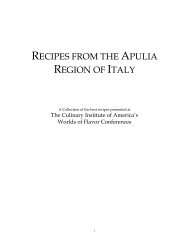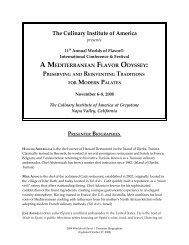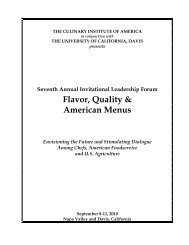Authentic Flavors for American Menus - CIAProChef.com
Authentic Flavors for American Menus - CIAProChef.com
Authentic Flavors for American Menus - CIAProChef.com
Create successful ePaper yourself
Turn your PDF publications into a flip-book with our unique Google optimized e-Paper software.
Cashew Nuts (kashunandi) Cashews arrived in India from Brazil by way of the Portuguese. The plants thrived<br />
in Kerala’s climate, and today South India is one of the world’s leading exporters of cashews. Only raw, unsalted<br />
nuts are used in cooking; they are either fried in ghee (clarified butter) <strong>for</strong> a garnish, or ground into a paste to<br />
thicken a curry. It’s not necessary to buy whole nuts because the broken pieces work fine in these recipes. (MK)<br />
Chapati Flour A very finely ground wholewheat flour found only at Indian grocers and used <strong>for</strong> making Indian<br />
breads. If unavailable, use suggested <strong>com</strong>binations of wholewheat or wheatmeal flour and plain flour/white<br />
flour. (MJ)<br />
Chickpea Flour Flour made out of chickpeas. In Indian shops it is known as gram flour or besan. It is also<br />
available in Britain in health food shops and in the United States in specialty stores where it is known as farine de<br />
pois chiches. (MJ)<br />
Chiles, Fresh Hot Green (Hari Mirch) The fresh chiles used in India are 2 to 4-inches (5-10 cm) long and quite<br />
slim. They are generally green but sometimes ripen to a red colour and may be used just as easily. Besides being<br />
rich in vitamins A and C, their skins give Indian food a very special flavour. If other varieties of chiles are<br />
substituted, adjustments should be made as they could be very mild in flavour, such as Italian hot peppers or<br />
wildly hot, such as the Mexican jalapeño.<br />
To store fresh chiles, do not wash them. Just wrap them in newspaper and put them in a plastic container or<br />
plastic bag. Any chiles that go bad should be thrown away as they affect the whole batch.<br />
All chiles should be handled with care, especially when cut or broken. Refrain from touching your eyes or<br />
mouth, and wash your hands as soon as possible after you finish with them.<br />
If you want the flavour of the green chilli skin and none of its heat, remove its white seeds be<strong>for</strong>e cooking. (MJ)<br />
Chiles, Whole Dried Hot Red (Sabut Lal Mirch) These chiles are generally 1½-2½-inches (3.5 – 6 cm) long and<br />
quite slim. They too should be handled with care, just like the fresh hot green chiles. If you want the flavour of<br />
the chiles, without their heat, make a small opening in them and shake out and discard their seeds. (MJ)<br />
Whole dried red chiles are one of the many <strong>for</strong>ms of the capsicum to lend heat to South Indian curries. Browned<br />
in hot oil together with mustard seeds and curry leaves, dried chiles help <strong>for</strong>m the trademark seasoning of a<br />
Kerala curry. Some cooks break the chiles open be<strong>for</strong>e adding them to the oil, thereby releasing the seeds and<br />
making the dish hotter. They are sold under different names, but look <strong>for</strong> chiles that are 2 to 3 inches long, deep<br />
red, and unbroken. (MK)<br />
Chilli Powder, Red/Cayenne Pepper (Pisi Hui Lal Mirch) Indians refer to ground dried red chiles as red chilli<br />
powder. This is not the ‘chilli powder’ used in America to make Mexican “chile.” <strong>American</strong> ‘chilli powder’ is a<br />
spice mixture which includes ground cumin seeds. Because of this confusion, I have been <strong>for</strong>ced to write ‘red<br />
chilli powder (cayenne pepper)’, even though I’m aware that cayenne is a particular red chilli. Indian red chilli<br />
powder and cayenne pepper may be used interchangeably. (MJ)<br />
This is the dried powdered <strong>for</strong>m of ripe capsicums otherwise known as red chili peppers. In Kerala they use<br />
Kashmiri chili powder, which has a bright red color and a tempered heat. Since that type is milder than the<br />
cayenne we purchase here, South Indian curries can take on a pretty shade of red without being overwhelmingly<br />
hot. Use our cayenne judiciously, because if overdone, its heat is sharp on the back of the throat. (MK)<br />
Cinnamon (Karuvapatta) Another spice from Kerala, cinnamon adds a sweet and intense perfume to chicken<br />
and meat curries. Often used in <strong>com</strong>bination with whole cloves, cinnamon stick brings a rich aroma to Kerala’s<br />
outstanding coconut milk stews. It is also one of the ingredients in garam masala, the sweet and hot spice blend<br />
found in Muslim dishes across India, such as kurma and biriyani. (MK)<br />
Cloves (grambu) Cloves originated in the Spice Islands (Indonesia), and were probably brought to India <strong>for</strong><br />
cultivation by Portuguese spice traders. Whole cloves are the dried unopened flower buds of the clove tree. Their<br />
sweet yet sharp flavor adds a warm layer to the same meat and vegetable curries in which cinnamon is used. In<br />
its ground <strong>for</strong>m it is one of the ingredients in the spice blend garam masala. (MK)<br />
Coconut, Grated Fresh When buying coconuts, make sure that they have no mould on them and are not cracked.<br />
Shake them to make sure that they are heavy with liquid. The more liquid the better. To break a coconut, hold<br />
46<br />
WORLDS OF FLAVOR CONFERENCE AND FESTIVAL V1.1 THE CULINARY INSTITUTE OF AMERICA ®<br />
SAVORING ASIA—AUTHENTIC FLAVORS FOR AMERICAN MENUS










